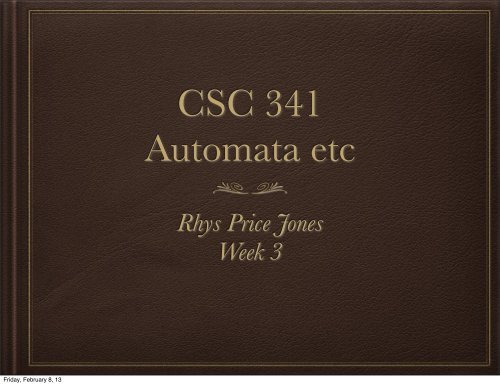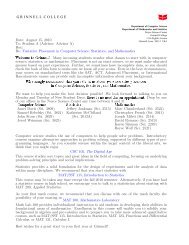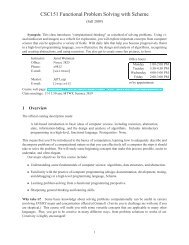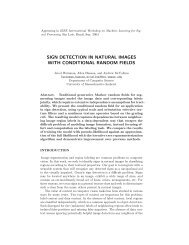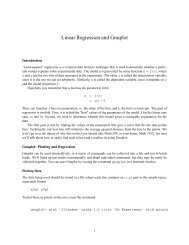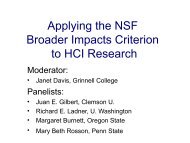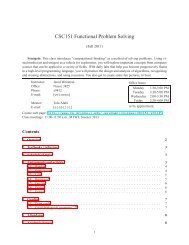Lecture 3
Lecture 3
Lecture 3
You also want an ePaper? Increase the reach of your titles
YUMPU automatically turns print PDFs into web optimized ePapers that Google loves.
CSC 341<br />
Automata etc<br />
Rhys Price Jones<br />
Week 3<br />
Friday, February 8, 13
Proving a Language is Regular<br />
Method 1<br />
Build a FA for it<br />
Example L = {w | w∊(0+1)*, binary number<br />
w is divisible by 5}<br />
Now convince<br />
me L = L(M)<br />
Friday, February 8, 13
Proving a Language is Regular<br />
Method 2<br />
Describe a FA for it<br />
Example L = {w | w∊(0..F)*, hex number w is<br />
divisible by 479}<br />
M has 480 states q1..q480<br />
qn corresponds to “The string so far is a binary number congruent to n mod 479”<br />
Except q480 corresponds to congruence to 0<br />
δ(qi,0) = qj iff j ≡ 16i mod 479<br />
Now convince<br />
δ(qi,1) = qj iff j ≡ 16i+1 mod 479...<br />
δ(qi,F) = me L = L(M)<br />
qj iff j ≡ 16i+15 mod 479<br />
Start state q0 has δ(q0,0) = q481, δ(q0,i) = qi<br />
Accept states q481 and q480<br />
Friday, February 8, 13
Proving a Language is Regular<br />
Method 3<br />
Give me a r.e. for it<br />
Example L = {w | w∊(0+1)*, w is a bunch of 0<br />
followed by a bunch of 1 followed by a bunch of 0}<br />
r = 0 * 1 * 0 *<br />
Now convince<br />
me L = L(r)<br />
Friday, February 8, 13
Proving a Language is Regular<br />
Method 4<br />
Describe a r.e. for it<br />
Example L is a finite language consisting of<br />
the strings w1,w2,..wn<br />
r = w1+w2+..wn<br />
Now convince<br />
me L = L(r)<br />
Friday, February 8, 13
Proving a Language is Regular<br />
Method 5<br />
Use closure properties<br />
Example L = {w∊(0+1)* | w is a binary<br />
number divisible by 5 consisting of a bunch of<br />
0s squeezed between two bunches of 1s}<br />
We know<br />
1) {binary numbers divisible by 5} is regular<br />
2) bunch of 0s squeezed between 1s is 1 * 0 * 1 *<br />
hence regular<br />
Cite closure under intersection and we’re done!<br />
Friday, February 8, 13
I like closure properties!!!<br />
How can we get more?<br />
Friday, February 8, 13
Proving new closure properties<br />
Method 1<br />
Use already derived closure properties<br />
Example: Closure under intersection<br />
We know<br />
1) Reg langs closed under ∪ and complement<br />
2) De Morgan’s laws<br />
If L1 and L2 are regular, so are<br />
C(L1) and C(L2) ..... closure under complement<br />
C(L1) ∪ C(L2) is regular ...... closure under ∪<br />
L1∩L2 = C(C(L1) ∪ C(L2)) ..... de Morgan<br />
and is regular by closure under complement<br />
Friday, February 8, 13
Proving new closure properties<br />
Method 2<br />
Adapt a machine<br />
Example: If L is regular so is L’ = {a1a3a5..a2n-1 | a1..a2n∊L}<br />
Let M be a DFA for L<br />
Define δ’(p,a) = {δ(p,ab) |<br />
b∊Σ}<br />
I extended δ:Q×Σ* → Q in the<br />
obvious way<br />
Make δ’ : 2 Q → 2 Q using union<br />
∀P⊆Q, δ’(P,a) = ∪p∊Pδ’(p,ab)<br />
F’ is subsets of Q containing<br />
a state of F<br />
M’ = (Q,Σ,δ’,{q0},F’) is an NFA for L’<br />
Proof ?<br />
Prove by induction on n that<br />
δ’(P,a1..an) = ∪q∊P{δ(q,a1b1a2b2..bn-1anbn) | bi∊Σ}<br />
Clearly if n=0, δ’(P,ε)={δ(q,ε) | q∊P}=P<br />
Assume ind.hyp. true ∀i
Short Diversion<br />
The regular languages are NOT closed under<br />
“subset”<br />
If L1 is regular and L2 ⊂ L1 it is not necessarily true<br />
that L2 is regular<br />
The regular languages are not closed under “infinite<br />
union”<br />
If L1,L2,...,Li,... are regular it is not necessarily the<br />
case that L1∪L2∪...∪Li∪... is regular<br />
Friday, February 8, 13
Sipser Problem 1.42<br />
A,B regular with DFAs MA,MB<br />
Show regular SHUFFLE(A,B) =<br />
{w=a1b1..akbk | a1..ak∊A, b1..bk∊B, each ai,bi ∊ Σ * }<br />
Q=QA×QB, q0=(qA0,qB0), F=FA×FB<br />
δ((qA,qB),a) = {(δA(qA,a),qB), (qA,δ(qB,a))}<br />
Friday, February 8, 13
Another example<br />
If L is regular, so is<br />
Cycle(L) = {a2a1a4a3..a2na2n-1 | a1a2a3a4..a2n-1a2n ∊ L}<br />
Let M be a DFA for L.<br />
M’ will be a DFA for Cycle(L) that uses a state to “remember” what symbol (a) it just<br />
read.<br />
Then, when it reads the next symbol b, M’ will simulate M on input ba. Formally<br />
Q’ = Q ∪ (Q×Σ)<br />
δ’(q,a) = (q,a)<br />
δ’((q,a),b) = δ(q,ba)<br />
Prove by induction on n that<br />
δ’(q,a2a1a4a3..a2na2n-1) = δ(q,a1a2a3a4..a2n-1a2n)<br />
Clearly true when n=0 since δ’(q,ε) = q = δ(q,ε)<br />
Assume true for n-1, so δ’(q,a2a1a4a3..a2n-2a2n-3) = δ(q,a1a2a3a4..a2n-3a2n-2) = p, say<br />
Then δ’(q,a2a1a4a3..a2na2n-1) = δ’(δ’(q,a2a1a4a3..a2n-2a2n-3), a2na2n-1)<br />
= δ(p, a2n-1a2n) = δ(δ(q,a1a2a3a4..a2n-3a2n-2), a2n-1a2n) = δ(q,a1a2a3a4..a2n-1a2n)<br />
We have proved that a2a1a4a3..a2na2n-1 is accepted by M’ if and only if<br />
a1a2a3a4..a2n-1a2n is accepted by M. So Cycle(L) = L(M’) is regular.<br />
Friday, February 8, 13
Similar examples<br />
Under which of these are reg langs closed?<br />
MAX(L) = {x∊L | xy ∊ L ⇒ y=ε}<br />
MIN(L) = {x∊L | (x=yz and y∊L) ⇒ z=ε}<br />
INIT(L) = {x∊L | ∃y and xy∊L}<br />
SQRT(L) = {x | for some y with |y|=|x| 2 xy∊L}<br />
Friday, February 8, 13
Similar examples<br />
MAX(L) = {x∊L | xy ∊ L ⇒ y=ε}<br />
What is MAX(1*0*1)?<br />
Friday, February 8, 13
Quotient of languages<br />
If L1 and L2 are languages then<br />
L1/L2 = {x | ∃y∊L2 such that xy∊L1}<br />
It’s true that if L1 and L2 are regular so is L1/L2<br />
But here’s a stronger result<br />
If L is a regular language and S is an arbitrary<br />
set then L/S is regular<br />
Friday, February 8, 13
Proof (not effective!)<br />
If L is a regular language and S is an arbitrary set then L/S is regular<br />
Let M = (Q,Σ,δ,q0,F) be a DFA for L<br />
There is a DFA M’= (Q,Σ,δ,q0,F’) that accepts L/S<br />
M’ behaves just like M, but F’ consists of just<br />
those states for which ∃y∊S such that δ(q,y)∊F<br />
I don’t (and cannot in general) know what F’ is<br />
but I know it exists!<br />
Friday, February 8, 13
Proving language no regular<br />
In general this is harder!<br />
We need a property that all regular languages<br />
possess<br />
And a way to show that a language does not<br />
possess that property<br />
The property: “pumpability”<br />
Friday, February 8, 13
Proof (before the theorem!)<br />
A DFA has a finite number (say N) of states<br />
If a string w of length n>N is accepted then<br />
some state (say p) is revisited<br />
Let x be the prefix of w eaten on the way from q0 to p(first visit)<br />
Let y be the middle part of w eaten on the way from p (first visit) to p<br />
(second visit)<br />
Let z be the rest of w<br />
So w = xyz with |xy|≦ N, |y|>0<br />
xy i z is accepted by the DFA ∀i≧0<br />
Friday, February 8, 13
Theorem (Pumping Lemma)<br />
If A is a regular language, then there is a<br />
number p (called the pumping length) such that<br />
whenever s is a string in A of length ≥ p, then s<br />
may be written s=xyz satisfying:<br />
for each i ≥ 0, xy i z ∊ A,<br />
|y| > 0, and<br />
|xy| ≤ p<br />
Friday, February 8, 13
Use to prove {0 n 1 n | n≥0} not reg<br />
EvilOne: Oh Yes it is regular!<br />
Me: OK, so give me p<br />
EvilOne (gives me a constant p)<br />
Me: You’ll agree s = 0 p 1 p ∊L with length ≥ p<br />
EvilOne: Of course<br />
Me: Now you split s = xyz according to the rules<br />
Friday, February 8, 13
The Battle Continues<br />
EvilOne must give me x=0 a , y=0 b ,z=0 p-(a+b) 1 p<br />
for some a≥0 and b≥1<br />
Me: You lose! Obviously xy 0 z = 0 a 0 p-(a+b) 1 p ∉ L<br />
since a+p-(a+b) = p ⇒ b=0<br />
and we know b>0<br />
EvilOne walks off with tail between legs<br />
Friday, February 8, 13
L = {ww R | w ∊ (0+1) * } is not reg<br />
Proof: We need to give EvilOne a string in that<br />
cannot be pumped without leaving the language.<br />
Pumping must occur within p of beginning<br />
So choose s carefully with a beginning portion:<br />
that is clearly identifiable<br />
clearly makes s be of the required form<br />
breaks the defining property when it’s pumped<br />
Friday, February 8, 13
Myhill-Nerode Theorem<br />
do by hand<br />
dealt with lightly in Sipser<br />
and then in JFLAP<br />
Exercise 1.51 and 1.52<br />
has as a consequence the<br />
basis of a minimization<br />
algorithm for DFAs<br />
Minimize this:<br />
toMinimize.jff<br />
Friday, February 8, 13


